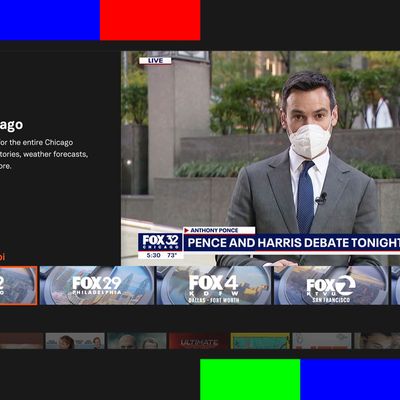
Donald Trump loves to brag about how good his presidency has been for TV news ratings, and for once, he’s not lying: Primetime viewership for all three major cable-news networks has surged since he took office. Nightly newscasts on ABC, CBS, and NBC have also benefited, with Nielsen numbers staying flat or growing even as ratings for just about everything else on linear TV have plummeted. But news-industry execs know the same trends that led to massive audience declines in primetime viewership will eventually catch up to them. Rather than waiting around until it’s too late, they’re responding by mounting a fierce and increasingly well-funded battle for streaming-news supremacy.
Though nowhere near as sexy as the death match between Netflix and Disney+, the land grab among the traditional TV news powers scrambling for turf in the streaming space is becoming impossible to ignore. While ABC, CBS, NBC, and Fox have all had some sort of streaming presence for a few years now — CBS launched its always-on digital news network CBSN all the way back in 2014 — those efforts have been supersized over the past year or so. More money is being spent to hire talent specifically for streaming, outlets are expanding original programming into new dayparts (including the highly competitive morning hours), and companies are pushing to increase localization so that newscasts from New Orleans or Seattle are as easy to stream as the latest installment of CBS Evening News. There’s also been a big strategic shift: Instead of simply trying to get consumers to click over to standalone apps, news conglomerates are making their programming omnipresent across the streaming universe, particularly on free, ad-supported platforms such as Tubi, Pluto, and the Roku Channel. Among the notable developments in recent months:
➽ NBCUniversal has been bulking up its main streaming network, NBC News NOW, which this week jumped into the early show fray with Morning News NOW. The four-hour, live weekday block builds upon the eight hours per day of live programming the platform had already been running. While not the first streaming morning show, it’s still a big deal given NBC has the enduringly popular Today show while sister network MSNBC airs its successful Morning Joe. Execs, however, clearly feel there’s enough potential digital viewership to be had without chipping away at the audience for linear platforms. NOW also recently added a weekly show from Meet the Press anchor Chuck Todd and has been producing a series of election-related special reports.
➽ Beyond building NOW, NBC News has also turned Today into its own digital channel on sister streamer Peacock as well as outside platforms such as Pluto, with segments from the show and exclusive content streaming around the clock. And while NBC News isn’t formally involved, NBCU-owned Peacock recently launched two daily news shows anchored by MSNBC regulars Mehdi Hasan and Zerlina Maxwell. (Political side note: Hasan’s calm, focused grilling of John Bolton Wednesday over the Iraq war was masterful and better than most interviews you’ll find on cable news. Take 15 minutes and check it out.)
➽ Just before the pandemic hit, ABC News Live added a new signature nightly newscast in February (ABC News Live Prime) and then in July expanded its daytime coverage to include four additional hours of original programming. It also debuted a weekday afternoon political show late last month. The service has gotten a boost from being added to its fellow Disney property Hulu (even for subscribers who don’t pay for live TV service), as well as Google’s YouTube TV. (NBC News NOW is also on YouTube TV, while CBSN is included on Hulu with Live TV.)
➽ CBSN, which launched the streaming news wars when it launched back in 2014, hasn’t expanded quite as much this past year, but that’s mostly because it was already far ahead of most of its rivals in terms of distribution and programming (it has long had a morning show and a politics-themed show). The biggest evolution for CBSN of late has been the launch of ten CBSN local channels in cities where CBS owns local stations, including New York and Los Angeles. (Three more are on the way in coming months, CBS says.) CBSN has also taken advantage of synergy from ViacomCBS-owned sibling Pluto, which has added multiple CBSN channels to its service (though only the New York and L.A. versions of CBSN can be seen nationally). The network has also expanded its slate of original documentary-style series, with over five dozen produced to date.
➽ Tubi, the free streaming service recently acquired by Rupert Murdoch’s Fox, last week unveiled “News on Tubi,” a dedicated portal offering nearly a dozen national and global streaming news feeds (including NBC News Now, Canada’s CBC News, Cheddar, and Fox-owned NewsNOW) plus live feeds from 17 different Fox-owned local TV stations. Tubi also announced a deal to begin offering local newscasts from Hearst-owned stations later this month, as well as the Spanish-language news network Estrella News. News on Tubi arguably represents the most aggressive aggregation of local news content on a major general interest streaming service yet, surpassing CBS’s already-impressive offering. (Both Tubi and CBSN are playing catch-up with smaller platforms such as Sinclair-owned STIRR, which offers news programming from over 100 different local stations alongside a slew of entertainment programming, or the news-only NewsON app.)
➽ CNN, which has long offered streaming access to its cable subscribers via CNN Go, has also been moving into the free streaming space. The network has quietly been rebroadcasting many of its big live shows (such as Jake Tapper’s The Lead) on a dedicated Pluto channel, letting cordcutters who don’t have access to CNN Go a chance to watch CNN content for free. More importantly, CNN parent WarnerMedia has been dropping hints that some form of CNN will be a key part of the reduced cost (or possibly free) version of HBO Max it is planning to debut next year. CNN is already producing documentary content for Max.
Why all the sudden interest in news for streaming? Much of the push into news for streaming platforms was initially driven by established outlets looking to capture younger audiences who have simply never been big consumers of TV news and have largely abandoned linear TV. That was also the idea behind digital native platforms such as Cheddar and Newsy, which have been engineered to appeal to millennial eyeballs. While companies new and old are still on the hunt for younger viewers, the expansion lately is largely being driven by the rise of advertiser-supported video on demand (AVOD) platforms such as the aforementioned Pluto and Tubi. AVODs aren’t looking to play the same game as a Netflix or HBO Max.
Instead, they’re basically looking to reinvent cable, complete with electronic program guides and channels that air endless reruns of the same show — but minus the monthly bill. News was always a key driver of cable and broadcast TV, so it’s only logical AVODs would make the ability to watch local and national news on demand a key part of their offering. What’s more, AVODs need cost-effective ways to get viewers into their ecosystems, since most — save for NBCU’s Peacock — aren’t about to invest $50 million for a big scripted series. Live news channels offer an easy way for AVODs to increase their curb appeal to streaming viewers without breaking the bank. And news also just happens to be one of the few programming genres where there’s no competition from Netflix — leaving the race to grab eyeballs wide open.
Elsewhere This Week: Disney, Eddie Murphy, and Cats
➽ There was big news out of Disney this week: The company Monday said it was restructuring its media and entertainment business in a way designed to “accelerate the company’s direct-to-consumer strategy.” Kareem Daniel, a Disney vet who had been working in the company’s consumer product division, is now in charge of something called the Media and Entertainment Distribution group. So what does that mean? There was some early online speculation that Daniel would now be in charge of deciding whether the movies and TV shows various Disney units make would debut on streaming, in theaters, or on linear TV. But that does not seem to be the case at all. Instead, it seems like the top creative execs at Disney’s film and TV studios will now have more power than ever to determine what content to make, with Daniel in charge of making sure the distribution channels used to get that content to consumers are operating effectively (and making money). But whatever the nuts and bolts of the exec shuffling, the real message being delivered by Disney CEO Bob Chapek was pretty simple: The Mouse House is all in on streaming.
➽ It’s not official, but it looks like Paramount’s much-anticipated Eddie Murphy sequel Coming 2 America will be headed to Amazon Prime Video instead of theaters. The news comes weeks after Amazon landed the rights to the semi-surprise Borat sequel (debuting next week) and Disney said its big Pixar release Soul would debut on Disney+ this December rather than in theaters. And as has been planned for some time, Sofia Coppola’s Bill Murray film On the Rocks, currently in a handful of movie theaters, will premiere on Apple TV+ next week. As Primetimer’s Joe Reid noted last month, Netflix’s fall feature film slate, just like last year, is packed with a slew of big, splashy titles. But thanks in part to COVID-related theater closures, Netflix’s rivals will be stocked with some impressive offerings of their own.
➽ Speaking of feature films, one of 2019’s most-anticipated-for-all-the-wrong-reasons movies finally made its way to pay cable a few days ago when Cats debuted on HBO last Saturday. Critics, of course, hated the musical adaptation, and it was a box-office turd. But maybe TV viewers would be curious to see what all the (negative) fuss was about? Nope! Per Nielsen, just 279,000 viewers tuned in for HBO’s cable premiere of Cats, making it the least-watched Saturday movie debut on the network this year. Even Downhill, the blink-and-you-missed-it comedy flop from last February, did better, attracting 406,000 viewers a few weeks ago. This is where I’d insert some sort of witty Cats-related pun, but sadly, they were all used up when the movie bombed the first time.


